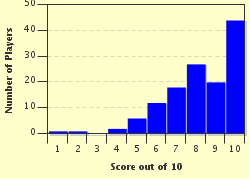Quiz Answer Key and Fun Facts
1. The finest European lace is made of which of the following types of thread?
2. As the Big Bopper could tell you, which type of lace is often dyed black?
3. Tatting is a type of lace making that is believed to have been inspired by the decorative ropework made by which of the following people?
4. Why was Torchon lace one of the most popular laces in Europe for centuries?
5. Which animal is used to make Shetland lace, known for the fineness of its thread?
6. One of the oldest types of European lace, known as Gros Point de Venise, originated in which of the following countries?
7. Which of the following men, originally from France, is recognized as the patron saint of lace-makers?
8. Which of these European rulers is often credited with making lace veils part of the matrimonial outfit for many English-speaking brides?
9. European lace was often used as a replacement for heavy embroidery.
10. Queen Anne's Lace was a very expensive silk lace that originated in the Black Forest of Germany in the 12th century.
Source: Author
dcpddc478
This quiz was reviewed by FunTrivia editor
WesleyCrusher before going online.
Any errors found in FunTrivia content are routinely corrected through our feedback system.

